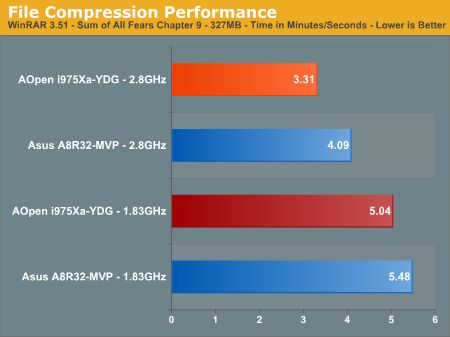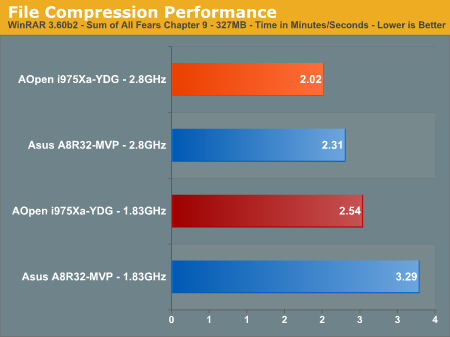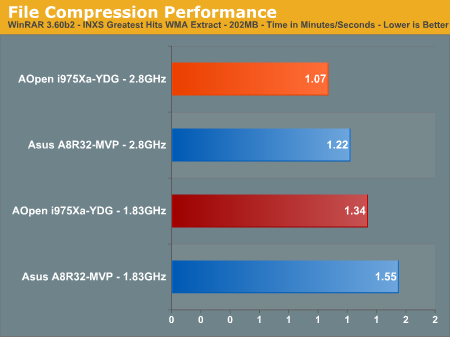Intel Core Duo: AOpen i975Xa-YDG to the Rescue
by Gary Key on May 4, 2006 8:00 AM EST- Posted in
- Motherboards
File Compression Performance
In order to save space on our hard drives and ensure we had another CPU crunching utility, we will be reporting our file compression results with two different versions of WinRAR. Our first file compression test utilizes WinRAR 3.51 to compress our Sum of All Fears Chapter 9 test file and our INXS Greatest Hits wma extraction tracks. All default settings in WinRAR are utilized along with our hard drive being defragmented before each test.

The Intel platform basically zips away from the AMD platform in our tests. File compression is a very CPU intensive application and also stresses the memory subsystem heavily. The added cache of Core Duo certainly helps in this particular test. The other interesting result is that our performance results scaled almost 1:1 with the increase in CPU speed, again indicative of a benchmark that makes good use of CPU cache. As an example, our Intel system has a 53% increase in CPU speed while the file compression numbers improved 52% in the Sum of All Fears benchmark and 59% in our INXS Greatest Hits compression test.
Our second series of file compression tests utilizes WinRAR 3.60b2 to compress the same files as before. All default settings are once again utilized in WinRAR along with our hard drive being defragmented before each test. This particular version of WinRAR fully supports multi-threading operations and should be of particular interest for those users with dual core or multi-processor systems.


The program update to WinRAR produces stunning results as we see drops of up to 66% in our Sum of All Fears results and 48% in the INXS Greatest Hits benchmark due to the multi-threading support. We also see the gap close up to 11% between the two platforms indicating our AMD Opteron has improved performance under this application. Basically, the multi-threading support in this version of WinRAR has negated the need for an additional 1GHz of CPU speed.










81 Comments
View All Comments
JarredWalton - Thursday, May 4, 2006 - link
Why did someone mod this post down? I'm serious: if you put an H in brackets, the AT comments engine interprets that as "turn on white text". No insult was intended towards HardOCP; I'm merely pointing out that Frumious' post turned the text white, unintentionally. Thanks for the negative mod points.... :|Frumious1 - Thursday, May 4, 2006 - link
Anyone else getting white text? What's up with that?Test:
[/font]
[/link]
Did that help?
goinginstyle - Thursday, May 4, 2006 - link
At least the quote was a bit different this time but still not needed. I thought the article was great and actually one of the best ones I have read lately. It was nice to finally see two like platforms compared against each other with the same cpu speeds and components although AMD2 would have been good to see.You really should do more of these comparisons as the reviewing one motherboard against another in the same product family gets boring. You never see much of a variance in the scores so the only question is if it sucks or not. At least this way you review the board and compare it against something you might be thinking about buying if you are a Intel or AMD user. You honestly get to see what works best for you. It was nice to see additional real application benchmarks instead of the same old winstone that or 3dmark this.
I was disappointed in not seeing any Photoshop benchmarks or something that has to do with graphics, it would round out your audio and video benchmarks nicely. Anyway, keep up the good work and hopefully you can do this same type of article when Conroe gets here against the AMD products.
In the meantime props to Intel for finally showing some performance improvement without needing a nuclear powerplant for the CPU.
goinginstyle - Thursday, May 4, 2006 - link
Any numbers yet?goinginstyle - Thursday, May 4, 2006 - link
....and temperature readings???Gary Key - Thursday, May 4, 2006 - link
We pulled the charts, the AOpen board uses a thermal sensor instead of the on-chip diode so our numbers are off. Once we decide what number to utilize, these numbers will be posted. If you refer to our Yonah Preview article, the power consumption numbers are listed for the 945GM board. I posted a couple of numbers earlier in this thread with the AOpen board. Thanks....goinginstyle - Thursday, May 4, 2006 - link
Thank you for the update and hopefully we can see these numbers soon.BigLan - Thursday, May 4, 2006 - link
"The rear panel contains the standard PS/2 mouse and keyboard ports, parallel port, LAN port, and 4 USB ports."Looking at the picture, I don't see a parallel port there and it's not listed on the specs either. Did you mean a firewire port?
Also, how useful is the external sata connector? Does the board come with a cable to utilise the power connector?
Gary Key - Thursday, May 4, 2006 - link
Sorry about that, yes, it was suppose to be Firewire. I had it corrected on my final draft and missed it twice in the edits.AOpen ships an excellent cable that has the drive and power port plugs together. I found the external connector to be very useful during testing on the JMicron chipset. Since I really enjoy HTPC tinkering, it will be of great usefulness for attaching or swapping large PVR drives out without entering the system. The JMicron chipset performed very well in our testing and had no issues handling Seagate's new 750GB drive.
BigLan - Thursday, May 4, 2006 - link
Thanks for the reply. Any chance you need an independent review doing on that 750GB drive ;)